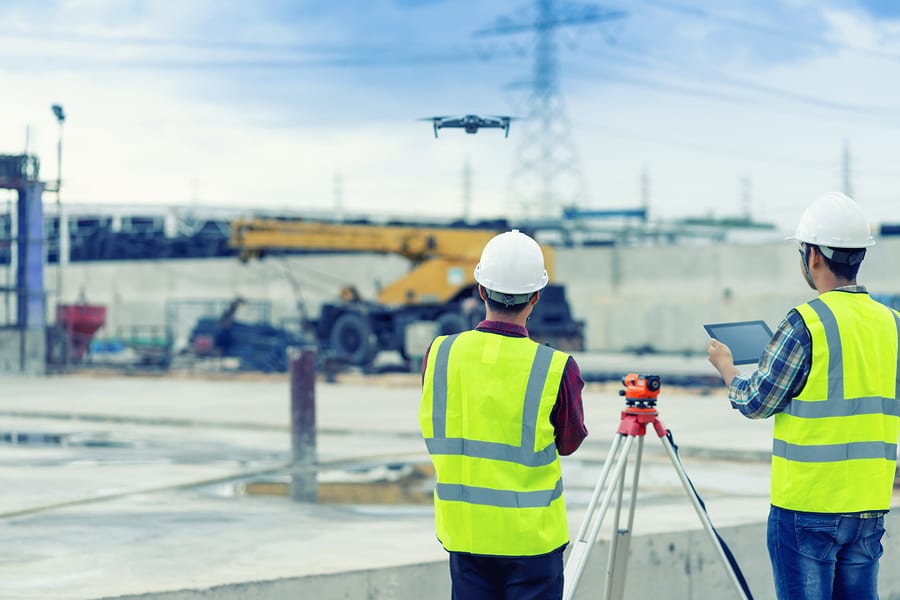Drones aren’t just for early adopters anymore — the construction industry is embracing the technology at a rapid pace. Unmanned aerial vehicles (UAVs) aren’t just gaining traction because they’re a fun, new gadget. It’s also because they have massive impacts on productivity.
From the jobsite to the corner office, we’ve seen stakeholders involved in every part of the construction project process realize the productivity benefits of drones. Small but mighty drones can help circumvent communication barriers and seriously cut down on labor costs. Here’s how.
To expedite project planning
Planning a construction project — no matter what the size — can be a long, costly process. And site inspections are a critical part of the planning process. Stakeholders need a comprehensive overview of the site to inform crucial decisions, including what equipment to rent, how many subcontractors to hire, and what building materials to buy.
Using a drone, planners can inspect a site in a fraction of the time it’d take someone to walk and manually document key data points. Plus, having access to that high-quality aerial video footage helps eliminate surprises, so your project design will be more accurate from the onset.
To super-power safety surveillance
OSHA reports 21% of workplace fatalities were in the construction industry, so safety should be paramount on all construction sites. But expecting a supervisor to catch every small misstep and hazard? That’s an unattainable goal — and that’s where having a second pair of (electronic) eyes comes in.
Drones don’t replace human safety supervisors. But their powerful, alternative vantage point makes them terrific assistants. Access to a bird’s-eye view can help a supervisor spot unsafe conditions at heights, an unmanned trench on the verge of collapse, or other dangerous hazards in a snap. Further, since drones can help stop accidents before they happen, employees feel safer and projects are more productive.
To conduct budget-friendly building inspections
Building inspection results heavily influence project scope and budget — primarily since surprises lie around every corner. However, traditional commercial and high-rise building inspections aren’t just time-consuming; they put workers in harm’s way.
Employing a drone for building inspections can result in both cost- and time-savings. In fact, using drones instead of erecting scaffolding as a way for workers to scale a building can save up to 80%. And once you get the all-clear from a video inspection, you can move on to the next step in the project without having to clean up from any human-led inspections.
To make meetings more meaningful
Are monotonous, fruitless, and boring project meetings filled with discussion on expense reports and punch lists the norm for your team? If you include drone video footage in your meetings, you can easily change the standard.
Drone footage gives everyone something to look forward to in meetings — it’s visually compelling and makes communicating project progress a breeze. Plus, studies suggest that, three days after an event, people retain 10% of what they hear from an oral presentation as opposed to 65% from a visual and oral presentation. That results in less explaining for the leader and a more engaging presentation for the team. It’s a productivity win-win.
To perform swift site surveys
Nothing provides valuable planning insights quite like a site survey. But until recently, getting a comprehensive, accurate land survey required labor, expensive surveying equipment, and lots of time.
Modern-day drones can collect data points with extreme ease, speed, and accuracy. This company even gathered the same results in three days that traditionally would have taken them 18! And since these data points integrate with mapping software (with little to no effort), it makes creating stunning maps and analyzing data easier than ever before.
To buckle down on jobsite security
On every construction job site, there are thousands, if not hundreds of thousands (or more), of pieces of equipment and materials that are vulnerable to theft when no one is around. Burglars love to target these sites — most estimates say the annual cost of construction equipment theft is approximately $400 million. And while security cameras can be handy for surveillance and theft deterrence, they have blind spots and can be easily dismantled.
Using drones to supplement or replace traditional security camera systems can boost productivity because you don’t have to take the time to find inconspicuous places to mount cameras. Plus, they’re much harder for thieves to spot and destroy, therefore eliminating the need to replace damaged equipment.
—
Interested in using a drone to streamline your construction processes? Contact us today for a free quote.

